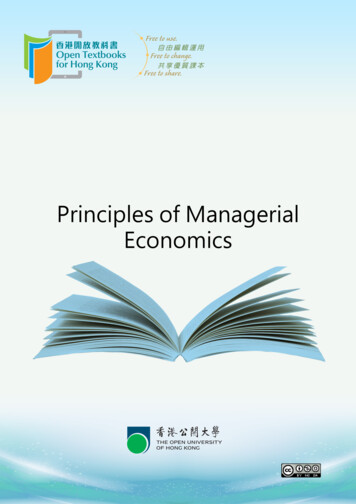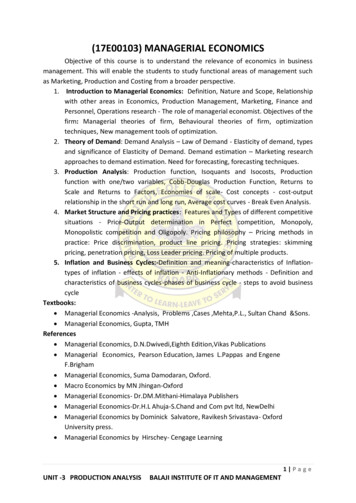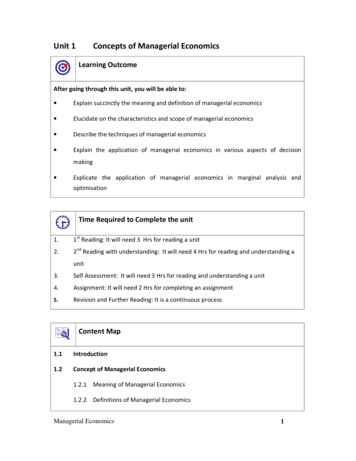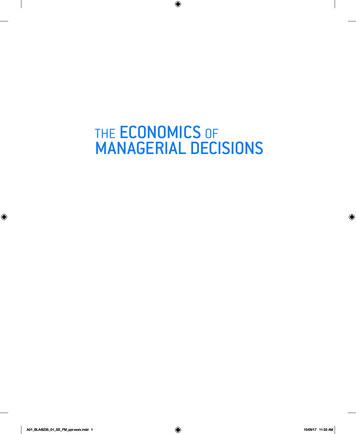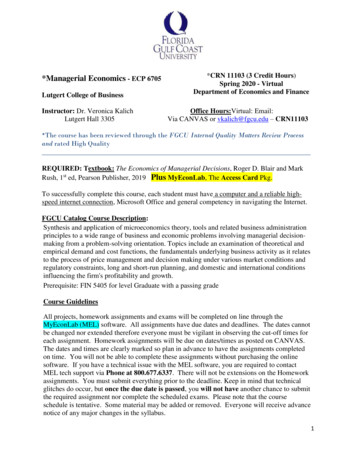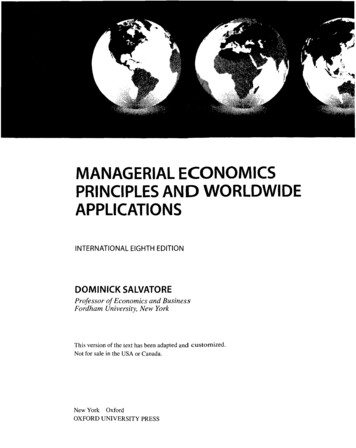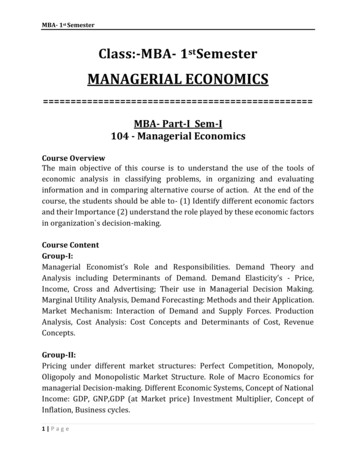
Transcription
MBA- 1st SemesterClass:-MBA- 1stSemesterMANAGERIAL ECONOMICS MBA- Part-I Sem-I104 - Managerial EconomicsCourse OverviewThe main objective of this course is to understand the use of the tools ofeconomic analysis in classifying problems, in organizing and evaluatinginformation and in comparing alternative course of action. At the end of thecourse, the students should be able to- (1) Identify different economic factorsand their Importance (2) understand the role played by these economic factorsin organization s decision-making.Course ContentGroup-I:Managerial Economist’s Role and Responsibilities. Demand Theory andAnalysis including Determinants of Demand. Demand Elasticity’s - Price,Income, Cross and Advertising; Their use in Managerial Decision Making.Marginal Utility Analysis, Demand Forecasting: Methods and their Application.Market Mechanism: Interaction of Demand and Supply Forces. ProductionAnalysis, Cost Analysis: Cost Concepts and Determinants of Cost, RevenueConcepts.Group-II:Pricing under different market structures: Perfect Competition, Monopoly,Oligopoly and Monopolistic Market Structure. Role of Macro Economics formanagerial Decision-making. Different Economic Systems, Concept of NationalIncome: GDP, GNP,GDP (at Market price) Investment Multiplier, Concept ofInflation, Business cycles.1 P ag e
MBA- 1st SemesterNote: students will receive an input of minimum 40 (class) contact hours ineach paper. In addition, students are also required to undertake a variety ofpractical assignments and group work under the supervision of faculty in everypaper.Pedagogy:-The instructor is expected to use leading pedagogical approachesin the class room situation. Research-based methodology, innovativeinstructional methods, extensive use of technology in the class room, onlinemodules of MOOCS, and comprehensive assessment practices to strengthenteaching efforts and improve student learning outcomes.The instructor of the class will engage in a combination of academic reading,analyzing case studies, preparing the weekly assigned readings, encouraging inthe class discussions, and live project based learning.Case/Class Discussion Assignments:Students will work in groups of upto four to prepare a brief write-up, due beforethe start of each class, covering the case study or class material to be discussedin the next session. Questions may include a quantitative analysis of theproblem, facing the decision-maker in the case.Class Participation:Attendance will be taken in each class. Class participation is scored for eachstudent for each class.Recommended Texts and Readings: Students should focus on materialpresented in lectures. The text should be used to provide further explanationand examples of concepts and techniques discussed in the course: Edwin Mansfield, W. Bruce Allen, Neil A. Doherty, Keith Weigelt,Managerial Economics: Theory, Application and Cases, W. W. Norton &Co. Inc., 5th Edition. David Begg, Stanley Fisher, RudigeerDovrbusch, Economics, McGraw-HillBook Company Limited (U.K.). W.W. Haynes, V.L. Mote and S. Paul, Managerial Economics: Analysis andCases, Feffers and Simons Pvt. Ltd., Bombay.2 P ag e
MBA- 1st Semester Michael Bays; Mote, Paul and Gupta, Managerial Economics: Conceptsand Cases, Tata McGraw-Hill Publishing Company Limited, New Delhi,34th Edition. Joel Dean, Managerial Economics, Prentice-Hall of India Pvt. Ltd., NewDelhi, 1998. Ravindra H. Dholakia, Microeconomics for Management Students, OxfordUniversity Press, Delhi, 2007.Scheme of Examination: English will be the medium of instruction and examination. Written Examinations will be conducted at the end of each semester asper the Academic Calendar notified in advance. This course carries 100 marks of which 50 marks shall be reserved forinternal assessment and the remaining 50 marks for written examinationto be held at the end of each semester. The duration of written examination for each paper shall be three hours. The internal assessment marks shall be based on factors such as: (a) Midterm test (20 marks), Submission of written assignments (20marks), andParticipation in case studies/ discussion, and group activities (10 marks),The weightage given to each of these factors shall be decided andannounced at the beginning of the semester by the individual teacherresponsible for the paper, and the marks obtained shall be made open tothe students and also shown separately in the mark-sheet The minimum number of marks required to pass a paper shall be 40% inthe external examination and 40% in the aggregate of internal andexternal examination in each paper. There is no pass percentage forinternal part of the assessment. A minimum of 75% of classroom attendance is required in each subject.As per RUSA Scheme the syllabus is divided into two parts Group-I & II. Theinstructions for external examiners would be as follows:-3 P ag e
MBA- 1st Semester “The external paper will carry 50 marks and would be of three hoursduration. The question paper will be divided into three groups i.e., I, II,III. The question paper will consist of four questions each in group I andII. Each question in these groups carries 7.5 marks. Candidates will berequired to attempt four questions in all selecting not more than twoquestions from each of these group. The IIIrd group shall comprisecompulsory question carrying 4 short answer questions (2 from eachgroup) and will carry 20 marks (5 marks for each question).”INDEXSR.NO.TOPICSGROUP-I1Managerial Economist’s Role and Responsibilities.23Demand Theory and Analysis including Determinants of Demand.Demand Elasticity’s - Price, Income, Cross and Advertising; Their use inManagerial Decision Making.4Marginal Utility Analysis5Demand Forecasting: Methods and their Application.6Market Mechanism: Interaction of Demand and Supply Forces.7Production Analysis, Cost Analysis8Cost Concepts and Determinants of Cost9Revenue Concepts10Important Question/ Answers11GROUP-IIPricing under different market structures: Perfect Competition,Monopoly, Oligopoly and Monopolistic Market Structure.12Role of Macro Economics for managerial Decision-making.13Different Economic Systems4 P ag e
MBA- 1st Semester14Concept of National Income: GDP, GNP,GDP (at Market price)15Investment Multiplier16Concept of Inflation17Business cycles.18Important Question/ AnswersGROUP-IMANAGERIAL ECONOMICS INTRODUCTION OF MANAGERIAL ECONOMICSManagerial Economics (also called Business Economics) a subject firstintroduced by Joel Dean in 1951, is essentially concerned with the economicdecisions of business managers. It is a branch of Economics that appliesmicroeconomic analysis to specific business decisions (i.e. Economics appliedin business decision-making). Managerial Economics may be viewed asEconomics applied to problem solving at the level of the firm. The problems ofcourse relate to choices and allocation of resources, which are basicallyeconomic in nature and are faced by managers all the time. It is that branch ofEconomics, which serves as a link between abstract theory and managerialpractice. It is based on economic analysis for identifying problems, organizinginformation and evaluating alternatives. In other words Managerial Economicsinvolves analysis of allocation of the resources available to a firm or a unit ofmanagement among the activities of that unit. It is thus concerned with choiceor selection among alternatives. Managerial Economics is by nature goaloriented and prescriptive, and it aims at maximum achievement of objectives.5 P ag e
MBA- 1st Semester MEANING OF MANAGERIAL agerial Economic is combination of two words Managerial & Economics.Managerial means management & relating to Management & Managers.Economics means Economic growth & relating to trade, industry, money.Managerial Economics is a combination of Economic Theory & ManagerialTheory. Managerial economics is a discipline which deals with the applicationof economic theory to business management. It deals with the use of economicconcepts and principles of business decision making. Formerly it was known as“Business Economics” but the term has now been discarded in favor ofManagerial Economics.Managerial Economics may be defined as the study of economic theories, logicand methodology which are generally applied to seek solution to the practical6 P ag e
MBA- 1st Semesterproblems of business. Managerial Economics is thus constituted of that part ofeconomic knowledge or economic theories which is used as a tool of analysingbusiness problems for rational business decisions. Managerial Economics isoften called as Business Economics or Economic for Firms. Definition of Managerial Economics:“Managerial Economics is economics applied in decision making. It is a specialbranch of economics bridging the gap between abstract theory and managerialpractice.” – Haynes, Mote and Paul.“Business Economics consists of the use of economic modes of thought toanalyse business situations.” - McNair and Meriam“Business Economics (Managerial Economics) is the integration of economictheory with business practice for the purpose of facilitating decision makingand forward planning by management.” - Spencerand Seegelman.“Managerial economics is concerned with application of economic concepts andeconomic analysis to the problems of formulating rational managerialdecision.” – Mansfield NATURE OF MANAGERIAL ECONOMICSTo know more about managerial economics, we must know about its variouscharacteristics. Let us read about the nature of this concept in the followingpoints:7 P ag e
MBA- 1st Semester1] Art and Science: Managerial economics requires a lot of logical thinking andcreative skills for decision making or problem-solving. It is also considered tobe a stream of science by some economist claiming that it involves theapplication of different economic principles, techniques and methods to solvebusiness problems.2] Micro Economics: In managerial economics, managers generally deal withthe problems related to a particular organization instead of the whole economy.Therefore it is considered to be a part of microeconomics.3] Uses Macro Economics: A business functions in an external environment,i.e. it serves the market which is a part of the economy as a whole. Therefore, itis essential for managers to analyze the different factors of macroeconomicssuch as market conditions, economic reforms, government policies, etc. andtheir impact on the organization.4] Multi-disciplinary: It uses many tools and principles belonging to variousdisciplines such as accounting, finance, statistics, mathematics, production,operation research, human resource, marketing, etc.5] Prescriptive / Normative Discipline: It aims at goal achievement and dealswith practical situations or problems by implementing corrective measures.Management Oriented: It acts as a tool in the hands of managers to deal withbusiness-related problems and uncertainties appropriately. It also provides forgoal establishment, policy formulation and effective decision making.6] Pragmatic: It is a practical and logical approach towards the day to daybusiness problems. SCOPE OF MANAGERIAL ECONOMICSThe scope of managerial economics is not yet clearly laid out because it is adeveloping science. Even then the following fields may be said to generally fallunder Managerial Economics:1. Analysis and Forecasting: A business firm is an economic organisation whichis engaged in transforming productive resources into goods that are to be soldin the market. A major part of managerial decision making depends on accurateestimates of demand. A forecast of future sales serves as a guide to management8 P ag e
MBA- 1st Semesterfor preparing production schedules and employing resources. It will helpmanagement to maintain or strengthen its market position and profit base.Demand analysis also identifies a number of other factors influencing thedemand for a product. Demand analysis and forecasting occupies a strategicplace in Managerial Economics.2. Cost and production analysis: A firm’s profitability depends much on its costof production. A wise manager would prepare cost estimates of a range ofoutput, identify the factors causing are cause variations in cost estimates andchoose the cost-minimising output level, taking also into consideration thedegree of uncertainty in production and cost calculations. Productionprocesses are under the charge of engineers but the business manager issupposed to carry out the production function analysis in order to avoidwastages of materials and time. Sound pricing practices depend much on costcontrol. The main topics discussed under cost and production analysis are: Costconcepts, cost-output relationships, Economics and Diseconomies of scale andcost control.3. Pricing decisions, policies and practices: Pricing is a very important areaof Managerial Economics. In fact, price is the genesis of the revenue of a firm adas such the success of a business firm largely depends on the correctness of theprice decisions taken by it. The important aspects dealt with this area are: Pricedetermination in various market forms, pricing methods, differential pricing,product-line pricing and price forecasting.4. Profit management: Business firms are generally organized for earningprofit and in the long period, it is profit which provides the chief measure ofsuccess of a firm. Economics tells us that profits are the reward for uncertaintybearing and risk taking. A successful business manager is one who can formmore or less correct estimates of costs and revenues likely to accrue to the firmat different levels of output. The more successful a manager is in reducinguncertainty, the higher are the profits earned by him. In fact, profit-planningand profit measurement constitute the most challenging area of ManagerialEconomics.9 P ag e
MBA- 1st Semester5. Capital management: The problems relating to firm’s capital investmentsare perhaps the most complex and troublesome. Capital management impliesplanning and control of capital expenditure because it involves a large sum andmoreover the problems in disposing the capital assets off are so complex thatthey require considerable time and labour. The main topics dealt with undercapital management are cost of capital, rate of return and selection of projects.6. Government Regulation: There are endless implications of governmentregulations on the business firm and at times the legal environment of businessis as important as the economic environment. So, it is necessary to examine lawrelated applications of economic principles.7. Management of Public Sector Enterprises:-Managerial economics can alsobe applied to the decision making process of non-profit seeking and publicsector enterprises. Economists in various government departments and publicsector organizations are also concerned with project evaluation and costbenefit analysis. MANAGERIAL ECONOMICS IN RELATION WITH OTHER DISCIPLINESManagerial economics has a close linkage with other disciplines and fields ofstudy. The subject has gained by the interaction with Economics, Mathematicsand Statistics and has drawn upon Management theory and Accountingconcepts. Managerial economics integrates concepts and methods from thesedisciplines and brings them to bear on managerial problems.10 P a g e
MBA- 1st Semester1. Managerial Economics and Economics:Managerial Economics is economics applied to decision making. It is a specialbranch of economics, bridging the gap between pure economic theory andmanagerial practice. Economics has two main branches—micro-economics andmacro-economics.Micro-economics:-‘Micro’ means small. It studies the behaviour of theindividual units and small groups of units. It is a study of particular firms,particular households, individual prices, wages, incomes, individual industriesand particular commodities. Thus micro-economics gives a microscopic view ofthe economy.The roots of managerial economics spring from micro-economic theory. Inprice theory, demand concepts, elasticity of demand, marginal cost marginalrevenue, the short and long runs and theories of market structure are sourcesof the elements of micro-economics which managerial economics draws upon.It makes use of well known models in price theory such as the model formonopoly price, the kinked demand theory and the model of pricediscrimination.11 P a g e
MBA- 1st SemesterMacro-economics:-‘Macro’ means large. It deals with the behaviour of thelarge aggregates in the economy. The large aggregates are total saving, totalconsumption, total income, total employment, general price level, wage level,cost structure, etc. Thus macro-economics is aggregative economics.It examines the interrelations among the various aggregates, and causes offluctuations in them. Problems of determination of total income, totalemployment and general price level are the central problems in macroeconomics.Macro-economies is also related to managerial economics. The environment, inwhich a business operates, fluctuations in national income, changes in fiscal andmonetary measures and variations in the level of business activity haverelevance to business decisions. The understanding of the overall operation ofthe economic system is very useful to the managerial economist in theformulation of his policies.Macro-economics contributes to business forecasting. The most widely usedmodel in modern forecasting is the gross national product model.2. Managerial Economics and Theory of Decision Making:The theory of decision making is relatively a new subject that has a significancefor managerial economics. In the process of management such as planning,organising, leading and controlling, decision making is always essential.Decision making is an integral part of today’s business management. A managerfaces a number of problems connected with his/her business such asproduction, inventory, cost, marketing, pricing, investment and personnel.Economist are interested in the efficient use of scarce resources hence they arenaturally interested in business decision problems and they apply economicsin management of business problems. Hence managerial economics iseconomics applied in decision making.3. Managerial Economics and Operations Research:Mathematicians, statisticians, engineers and others join together anddeveloped models and analytical tools which have grown into a specializedsubject known as operation research. The basic purpose of the approach is to12 P a g e
MBA- 1st Semesterdevelop a scientific model of the system which may be utilized for policymaking.The development of techniques and concepts such as Linear Programming,Dynamic Programming, Input-output Analysis, Inventory Theory, InformationTheory, Probability Theory, Queuing Theory, Game Theory, Decision Theoryand Symbolic Logic.4. Managerial Economics and Statistics:Statistics is important to managerial economics. It provides the basis for theempirical testing of theory. It provides the individual firm with measures ofappropriate functional relationship involved in decision making. Statistics is avery useful science for business executives because a business runs onestimates and probabilities.Statistics supplies many tools to managerial economics. Suppose forecastinghas to be done. For this purpose, trend projections are used. Similarly, multipleregression technique is used. In managerial economics, measures of centraltendency like the mean, median, mode, and measures of dispersion, correlation,regression, least square, estimators are widely used.Statistical tools are widely used in the solution of managerial problems.For example: Sampling is very useful in data collection. Managerial economicsmakes use of correlation and multiple regression in business problemsinvolving some kind of cause and effect relationship.5. Managerial Economics and Accounting:Managerial economics is closely related to accounting. It is recording the financial operation of a business firm. A business is started with the main aim ofearning profit. Capital is invested / employed for purchasing properties such asbuilding, furniture, etc and for meeting the current expenses of the business.Goods are bought and sold for cash as well as credit. Cash is paid to creditsellers. It is received from credit buyers. Expenses are met and incomesderived. This goes on the daily routine work of the business. The buying of13 P a g e
MBA- 1st Semestergoods, sale of goods, payment of cash, receipt of cash and similar dealings arecalled business transactions.The business transactions are varied and multifarious. This has given rise to thenecessity of recording business transaction in books. They are written in a setof books in a systematic manner so as to facilitate proper study of their results. There are three classes of accounts:(i) Personal account,(ii) Property accounts, and(iii) Nominal accounts.Management accounting provides the accounting data for taking businessdecisions. The accounting techniques are very essential for the success of thefirm because profit maximization is the major objective of the firm.6. Managerial Economics and Mathematics:Mathematics is another important subject closely related to managerialeconomics. For the derivation and exposition of economic analysis, we requirea set of mathematical tools. Mathematics has helped in the development ofeconomic theories and now mathematical economics has become a veryimportant branch of economics.Mathematical approach to economic theories makes them more precise andlogical. For the estimation and prediction of economic factors for decision making and forward planning, mathematical method is very helpful. The importantbranches of mathematics generally used by a managerial economist aregeometry, algebra and calculus.The mathematical concepts used by the managerial economists are thelogarithms and exponential, vectors and determinants, input-out tables.Operations research which is closely related to managerial economics ismathematical in character. MANAGERIAL ECONOMICS IN DECISION MAKING.Managerial economics uses a wide variety of economic concepts, tools, andtechniques in the decision-making process. These concepts can be placed inthree broad categories:14 P a g e
MBA- 1st Semester1. The theory of the firm, which describes how businesses make a variety ofdecisions.2. The theory of consumer behavior, which describes decision making byconsumers.3. The theory of market structure and pricing, which describes the structureand characteristics of different market forms under which business firmsoperate. ROLE OF MANAGERIAL ECONOMICS IN DECISION MAKINGManagerial economics, or business economics, is a division of microeconomicsthat focuses on applying economic theory directly to businesses. Theapplication of economic theory through statistical methods helps businessesmake decisions and determine strategy on pricing, operations, risk,investments and production. The overall role of managerial economics is toincrease the efficiency of decision making in businesses to increase profitRole Of ManagerialEconomics In DecisionMakingPricingElasticvs. sk1) Pricing:- Managerial economics assists businesses in determining pricingstrategies and appropriate pricing levels for their products and services. Somecommon analysis methods are price discrimination, value-based pricing andcost-plus pricing.2) Elastic vs. Inelastic Goods:- Economists can determine price sensitivity ofproducts through a price elasticity analysis. Some products, such as milk, areconsider a necessity rather than a luxury and will purchase at most price points.This type of product is considered inelastic. When a business knows they areselling an inelastic good, they can make marketing and pricing decisions easier15 P a g e
MBA- 1st Semester3) Operations and Production:- Managerial economics uses quantitativemethods to analyze production and operational efficiency through scheduleoptimization, economies of scale and resource analyses. Additional analysismethods include marginal cost, marginal revenue and operating leverage.Through tweaking the operations and production of a company, profits rise ascosts decline.4) Investments:- Many managerial economic tools and analysis models areused to help make investing decisions both for corporations and savvyindividual investors. These tools are use to make stock market investingdecisions and decisions on capital investments for a business. For example,managerial economic theory can be used to help a company decide betweenpurchasing, building or leasing operational equipment.5) Risk:- Uncertainty exits in every business and managerial economics canhelp reduce risk through uncertainty model analysis and decision-theoryanalysis. Heavy use of statistical probability theory helps provide potentialscenarios for businesses to use when making decisions. MANAGERIAL DECISION MAKING PROCESS (5 STEPS)16 P a g e
MBA- 1st SemesterDecision making is crucial for running a business enterprise which faces a largenumber of problems requiring decisions.Which product to be produced, what price to be charged, what quantity of theproduct to be produced, what and how much advertisement expenditure to bemade to promote the sales, how much investment expenditure to be incurredare some of the problems which require decisions to be made by managers.The five steps involved in managerial decision making process areexplained below:1. Establishing the Objective:-The first step in the decision making process isto establish the objective of the business enterprise. The important objective ofa private business enterprise is to maximize profits. However, a business firmmay have some other objectives such as maximization of sales or growth of thefirm.But the objective of a public enterprise is normally not of maximization ofprofits but to follow benefit-cost criterion. According to this criterion, a publicenterprise should evaluate all social costs and benefits when making a decisionwhether to build an airport, a power plant, a steel plant, etc.17 P a g e
MBA- 1st Semester2. Defining the Problem:-The second step in decision making process is oneof defining or identifying the problem. Defining the nature of the problem isimportant because decision making is after all meant for solution of theproblem. For instance, a cotton textile firm may find that its profits aredeclining.It needs to be investigated what are the causes of the problem of decreasingprofits. Whether it is the wrong pricing policy, bad labour-managementrelations or the use of outdated technology which is causing the problem ofdeclining profits. Once the source or reason for falling profits has been found,the problem has been identified and defined.3. Identifying Possible Alternative Solutions (i.e. Alternative Courses ofAction):- Once the problem has been identified, the next step is to find outalternative solutions to the problem. This will require considering the variablesthat have an impact on the problem. In this way, relationship among thevariables and with the problems has to be established.In regard to this, various hypotheses can be developed which will becomealternative courses for the solution of the problem. For example, in case of theproblem mentioned above, if it is identified that the problem of declining profitsis due to be use of technologically inefficient and outdated machinery inproduction. The two possible solutions of the problem are:(1) Updating and replacing only the old machinery.(2) Building entirely a new plant equipped with latest machinery.The choice between these alternative courses of action depends on which willbring about larger increase in profits.4. Evaluating Alternative Courses of Action:-The next step in businessdecision making is to evaluate the alternative courses of action. This requires,the collection and analysis of the relevant data. Some data will be availablewithin the various departments of the firm itself, the other may be obtainedfrom the industry and government.The data and information so obtained can be used to evaluate the outcome orresults expected from each possible course of action. Methods such asregression analysis, differential calculus, linear programming, cost- benefit18 P a g e
MBA- 1st Semesteranalysis are used to arrive at the optimal course. The optimum solution will beone that helps to achieve the established objective of the firm. The course ofaction which is optimum will be actually chosen. It may be further noted thatfor the choice of an optimal solution to the problem, a manager works undercertain constraints.The constraints may be legal such as laws regarding pollution and disposal ofharmful wastes; they way be financial (i.e. limited financial resources); theymay relate to the availability of physical infrastructure and raw materials, andthey may be technological in nature which set limits to the possible output tobe produced per unit of time. The crucial role of a business manager is todetermine optimal course of action and he has to make a decision under theseconstraints.5. Implementing the Decision:- After the alternative courses of action havebeen evaluated and optimal course of action selected, the final step is toimplement the decision. The implementation of the decision requires constantmonitoring so that expected results from the optimal course of action areobtained. Thus, if it is found that expected results are not forthcoming due tothe wrong implementation of the decision, then corrective measures should betaken.However, it should be noted that once a course of action is implemented toachieve the established objective, changes in it may become necessary fromtime to time in response in changes in conditions or firm’s operatingenvironment on the basis of which deci
MANAGERIAL ECONOMICS INTRODUCTION OF MANAGERIAL ECONOMICS Managerial Economics (also called Business Economics) a subject first introduced by Joel Dean in 1951, is essentially concerned with the economic decisions of business managers.



